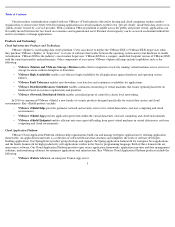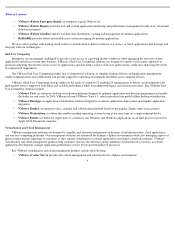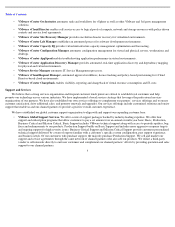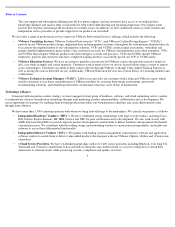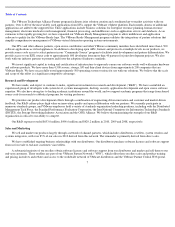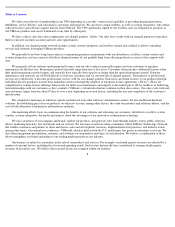VMware 2010 Annual Report Download - page 16
Download and view the complete annual report
Please find page 16 of the 2010 VMware annual report below. You can navigate through the pages in the report by either clicking on the pages listed below, or by using the keyword search tool below to find specific information within the annual report.
Table of Contents
margins, and could harm our ability to increase, or cause us to lose, market share. Increased competition also may prevent us from entering into
or renewing service contracts on terms similar to those that we currently offer and may cause the length of our sales cycle to increase. Some of
our competitors and potential competitors supply a wide variety of products to, and have well-established relationships with, our current and
prospective end-users. For example, small to medium sized businesses and companies in emerging markets that are evaluating the adoption of
virtualization-based technologies and solutions may be inclined to consider Microsoft solutions because of their existing use of Windows and
Office products. Some of these competitors have in the past and may in the future take advantage of their existing relationships to engage in
business practices that make our products less attractive to our end-users. Other competitors have limited or denied support for their applications
running in VMware virtualization environments. These distribution, licensing and support restrictions, as well as other business practices that
may be adopted in the future by our competitors, could materially impact our prospects regardless of the merits of our products. In addition,
competitors with existing relationships with our current or prospective end-users could in the future integrate competitive capabilities into their
existing products and make them available without additional charge. For example, Oracle provides free server virtualization software intended
to support Oracle and non-Oracle applications, and Microsoft offers its own server virtualization software packaged with its Windows Server
product and may offer built-in virtualization for future releases of the client version of Windows. By engaging in such business practices, our
competitors can diminish competitive advantages we may possess by incentivizing end-users to choose products that lack some of the technical
advantages of our own offerings.
We also face potential competition from our partners. For example, third parties currently selling our products could build and market their
own competing products and services or market competing products and services of third parties. If we are unable to compete effectively, our
growth and our ability to sell products at profitable margins could be materially and adversely affected.
Ongoing uncertainty regarding global economic conditions and the stability of regional financial markets may reduce information
technology spending below current expectations and therefore adversely impact our revenues, impede end-
user adoption of new products and
product upgrades and adversely impact our competitive position.
Our business depends on the overall demand for information technology and on the economic health of our current and prospective
customers. The purchase of our products is often discretionary and may involve a significant commitment of capital and other resources. Weak
economic conditions or significant uncertainty regarding the stability of financial markets could adversely impact our business, financial
condition and results of operations in a number of ways, including by lengthening sales cycles, affecting the size of enterprise license agreements
(“ELAs”) that customers will commit to, lowering prices for our products and services, reducing unit sales, reducing the rate of adoption of our
products by new customers and the willingness of current customers to purchase upgrades to our existing products.
Ongoing economic uncertainty has also resulted in general and ongoing tightening in the credit markets, lower levels of liquidity, increases
in the rates of default and bankruptcy and significant volatility in the credit, equity and fixed income markets. As a result, current or potential
customers may be unable to fund software purchases, which could cause them to delay, decrease or cancel purchases of our products and
services. Even if customers are willing to purchase our products and services, if they do not meet our credit requirements, we may not be able to
record accounts receivable or unearned revenue or recognize revenues from these customers until we receive payment, which could adversely
affect the amount of revenues we are able to recognize in a particular period.
In addition, although we plan to continue making strategic investments in our business, many of our competitors have significantly greater
financial, technical and other resources than we do, and if the economic recovery is anemic or not sustained, they may be better positioned to
continue investment in competitive technologies.
13


